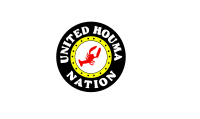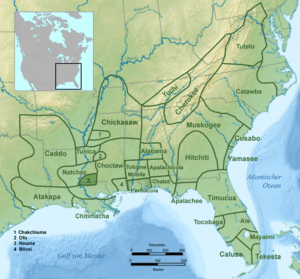Houma people facts for kids

Flag of the United Houma Nation
|
|
| Total population | |
|---|---|
| 10,837 registered (2010, US Census) | |
| Regions with significant populations | |
| Languages | |
| English, French, Louisiana French; formerly Houma language | |
| Related ethnic groups | |
| Choctaw and other Muscogeean peoples; Louisiana Creole people |
The Houma are a historic Native American people. They lived in Louisiana on the east side of the Red River of the South. Today, their descendants are known as the United Houma Nation. The state of Louisiana has recognized them as a tribe since 1972. However, the United States federal government does not yet officially recognize them.
The tribe says they have about 17,000 members. These members live in a large area covering six parishes (like counties) in Louisiana. These parishes are St. Mary, Terrebonne, Lafourche, Jefferson, Plaquemines, and St. Bernard.
The city of Houma is named after this people. The word "Houma" means "red." The Red River was also named after them. The state of Oklahoma has a similar name origin. The word humma means "red" in the Choctaw language and other related languages.
| Top - 0-9 A B C D E F G H I J K L M N O P Q R S T U V W X Y Z |
Plants and Traditional Uses
The Houma people have long used plants for medicine. For example, they use a special drink made from dried Gamochaeta purpurea to help with colds and the flu.
They also make a drink from the leaves and root of Cirsium horridulum mixed with whiskey. This drink helps clear phlegm from the lungs and throat. They also eat the soft, white center of this plant raw.
History of the Houma People
Early Beginnings
The Houma tribe likely spoke a language similar to the Choctaw people. A French explorer named René-Robert Cavelier, Sieur de La Salle first wrote about them in 1682. He noted they lived along the Red River near the Mississippi River.
The Houma's war symbol was the "Red Crawfish." Because of this, some experts think the Houma might have come from the Chakchiuma tribe. That tribe's name also comes from the word for "red crawfish."
After moving to what is now lower Lafourche and Terrebonne parishes, the Houma stayed in touch with other Choctaw groups. They used the many waterways for fishing, catching crawfish, and traveling. By the time French explorers arrived, the Houma were living near present-day Angola, Louisiana.
French Influence
In 1682, another French explorer, Brinson, mentioned passing near the "Oumas" village. This was the first time the Houma were written about in history. Later explorers gave more details about them.
When more Europeans arrived, they often misunderstood the different Native American groups. They sometimes thought each village was a separate tribe. The Bayogoula people were thought to be related to the Choctaw, like the Houma. Over time, some Choctaw groups moved into Louisiana.
Around 1699-1700, the Houma and Bayogoula tribes set a border for their hunting lands. They placed a tall red pole marked with sacred animal parts and feathers. The tribes called this marker Istrouma or Ete' Uma. The French called it Baton Rouge, which means "Red Stick." This spot later became the modern city of Baton Rouge, Louisiana.
In 1706, the Houma moved south from the Red River area. One reason was to be closer to their new French allies, who were mainly in New Orleans. They also wanted to move away from tribes allied with the English to the north.
From the 1730s to the French and Indian War (1754–1763), European wars affected North America. Many Native American tribes formed alliances with Europeans for protection. By 1739, the French reported that the Houma, Bayogoula, and Acolapissa tribes were joining together. The Houma tribe became a refuge for the last members of many other tribal nations.
By the early 1800s, the Houma had moved even further south. They settled in their current locations in Lafourche and Terrebonne parishes. The modern city of Houma, Louisiana, later grew in this area.
Early United States Era
After losing control of Saint-Domingue (now Haiti) due to a major revolution, France decided to sell the Louisiana colony to the United States. This sale, known as the Louisiana Purchase, happened on April 30, 1803. It greatly increased the size of the United States.
The treaty for the Louisiana Purchase said the U.S. would respect agreements between Spain and Native American tribes. However, the United States did not always follow this promise. An Indian agent named Dr. John Sibley counted only 60 Houma people in one area. Because many Houma were spread out and not counted, some U.S. officials wrongly thought the Houma people no longer existed.
In 1885, the Houma lost an important leader named Rosalie Courteau. She had helped them survive after the American Civil War. She is still highly respected today.
Modern Times
By the late 1800s, the Houma had developed their own version of the French language. This Houma-French language mixes early French words with some Houma words, like shaui for "raccoon." However, it is still a French language that can be understood by French speakers from other places. There are some differences in words, like chevrette for "shrimp." The accent is also unique, similar to how English speakers from different countries have different accents.
As southern Louisiana grew, the Houma remained somewhat isolated in their bayou communities. Their population was spread across six Native American settlements. People traveled between these settlements by pirogues (small boats) on the waterways. The state did not build roads connecting these communities until the 1940s. Like other Native American groups, the Houma often faced unfair treatment and separation.
In 1907, a researcher named John R. Swanton visited the Houma. He wrote about their way of life, which still involved hunting and gathering. They relied on the bayous and swamps for fish and game. They also grew small gardens for food. Today, some Houma members, like R.J. Molinere, Jr. and his son Jay Paul Molinere, are featured hunting alligators on the TV show Swamp People.
After the American Civil War, white leaders in Louisiana created laws to separate people by race. They often classified the Houma and other Native Americans as "free people of color." This meant Houma children had to attend schools for African American children, if any were available. The state was slow to build public schools in Houma areas. It was not until 1964, after the Civil Rights Act of 1964 ended segregation, that Houma children could attend public schools with all other children. Before this, many Houma children went to schools run by religious groups.
Government
The Houma people have their own government. It includes a council with elected representatives from each tribal district. They also elect a principal chief and a vice principal chief. The current principal chief is Lora Ann Chaisson.
Seeking Federal Recognition
In the 1790s, the Houma were given land on Bayou Terrebonne by the Spanish government. They were never forced to move to a reservation. Because they were a small tribe, the U.S. government largely overlooked them during the 1830s, when many Native American tribes were forced to move. Since they did not have recognized shared land, some thought they had lost their tribal status.
Also, after the U.S. bought Louisiana in 1803, state rules required everyone to be classified as either white or non-white. All Native Americans in Louisiana were often listed as "free people of color." This term had mainly been used for people of African and European descent. Later, the state adopted a very strict rule that classified anyone with any known African ancestry as Black. Many Houma people may have mixed ancestry but identify as Houma.
Records of the Houma people are found in regular local and church documents. These records show that the Houma people have remained a stable group in the area. Since the mid-1900s, the Houma have organized politically. They created a government and have been working to get official federal recognition as a tribe.
In 1979, the Houma tribe officially applied to the Bureau of Indian Affairs (BIA) for recognition. Their request was turned down in 1994 because the tribe lived in different settlements. The tribe sent more information in 1996 and is still waiting for their application to be reviewed again.
The Houma people have been spread out over a large area. Because of this, some groups, like the Pointe-Au-Chien Indian Tribe and the Biloxi-Chitimacha Confederation of Muskogee, have left the United Houma Nation. They felt too separated from other Houma people. These groups have gained state recognition and are also seeking federal recognition on their own.
The BIA has faced criticism for its strict rules for tribal recognition. In 2013, the BIA suggested new rules. Under these new rules, tribes would need to show they have been a continuous community since 1934. Before, they had to show continuity from the time of European contact. Many tribes argued that European settlement was exactly what caused disruptions. In 2014, the Houma were told their application was being actively reviewed under these new guidelines.
The state of Louisiana officially recognized the United Houma Tribe in 1972.
Coastal Erosion Challenges
Many Houma communities live in coastal areas. They rely on the swamps and bayous for food and their way of life. However, these areas are being severely affected by ongoing coastal erosion and the loss of wetlands.
Different factors from industrial growth have caused these losses. For example, shipping and oil companies have dug canals, which increases water movement and erosion. This also lets more saltwater into freshwater areas, killing wetland plants. Also, oil companies have buried pipes that were not covered enough.
The community of Isle de Jean Charles has suffered greatly from erosion. Scientists believe the island could be gone by 2030 if nothing is done. The Houma tribe is looking for land nearby to buy so they can move the whole community together. Coastal erosion has also harmed fishing. The tribe has seen fewer fish because saltwater has destroyed many traditional fishing spots.
Family Names
The Houma people, like many other Native American tribes, moved and shifted over many years. This has led to Houma people living among other Native American groups and marrying into different families. Over time, the Houma were encouraged to use European-style names. Also, many European men married Native women.
Today, most Houma people have European last names. Some common names include Billiot, Verdin, Dardar, Naquin, Gregoire, Parfait, Chaisson, Courteau, Solet, Verret, Fitch, and Creppel.
When the Houma tribe first began to organize as it is known today, some Native people from other groups thought they had to join the Houma to be recognized as Indian by the state. The word "Houma" means "red" in Choctaw, which was a common language for trade. The research needed for federal recognition has helped many people find their true ancestral tribal identity. This process of documenting ancestors has honored the Houma and other Native Americans who faced much unfair treatment in past generations.
Media
- Hidden Nation (1994) is a one-hour documentary video about the Houma people. It was made by Barbara Sillery & Oak Lea, Keepsake Productions (New Orleans).
See also
 In Spanish: Houma para niños
In Spanish: Houma para niños


